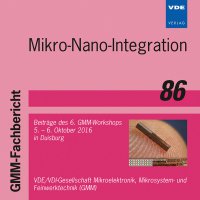Post-CMOS integration of miniaturized solar cells for energy harvesting of autonomous sensor nodes
Conference: Mikro-Nano-Integration - 6. GMM-Workshop
10/05/2016 - 10/06/2016 at Duisburg, Deutschland
Proceedings: Mikro-Nano-Integration
Pages: 5Language: englishTyp: PDF
Personal VDE Members are entitled to a 10% discount on this title
Authors:
Stuehlmeyer, Martin; Goehlich, Andreas; Figge, Martin; Vogt, Holger (Fraunhofer Institut für Mikroelektronische Schaltungen und Systeme IMS, Finkenstr. 61, 47057 Duisburg, Germany)
Abstract:
Besides the integration of sensor or actor elements by post-CMOS processing the energy harvesting by miniaturized components is of strong importance for novel applications in the frame of the “internet of things” and “industry 4.0”. The most common power source currently utilized is the conventional battery. Energy harvesting from ambient light is an efficient alternative way to circumvent the necessity to periodically replace such batteries. In the frame of an industrial development Fraunhofer IMS has developed recently a miniaturized photo cell that can be integrated monolithically on a CMOS-substrate, thus enabling the realization of extremely miniaturized sensor node. Thin film amorphous silicon cells can be integrated on CMOS-surfaces with the aid of low temperature PECVD processes. These cells are typically build up as p-i-n-diodes from doped a-Si:H-layers. The collection of photo-generated carriers is performed by suitable electrodes. In order to optimize the efficiency of such solar cells effective entrance layers have to be developed that exhibit a high optical transmission as well as high electrical conductivity. We report on experimental and simulation results of indium tin oxide (ITO) and aluminium doped zinc oxide (AZO) transparent conducting oxide (TCO) layers generated by different deposition methods.


